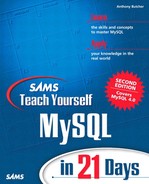Q&A
| Q1: | Is there a more graphical way to manipulate databases and tables than the command-line methods like mysql? |
| A1: | The mysql, mysqladmin, and other client programs require you to type commands longhand, but they are standard components of the MySQL client distribution and highly versatile, which is why you're advised to learn how to use them. If you prefer a more graphical method, you could try the phpMyAdmin program. This provides a convenient Web-based interface for almost all of MySQL's functions with minimal typing. However, to best learn MySQL's functionality and language, we recommend that you stick to the command-line programs while you're studying this book. |
| Q2: | How many databases or tables can be supported on a MySQL server? |
| A2: | MySQL allows virtually any number of databases, and any number of tables within each database. You're more likely to be limited by the number that you can manage effectively. |
| Q3: | How big can a MySQL table be? |
| A3: | The size of the largest possible MySQL table depends on the operating system MySQL is running on. With the MyISAM table type on MySQL version 3.23 and onward, the maximum table size is 8 terabytes. However, all data in a given table will be stored in a single file, and because of this, your operating system may limit a table size to be smaller than this.
For example, Linux on Intel can be 2GB, 4GB, or more depending on version. Linux on Alpha will probably handle 8TB. Solaris will support 2GB on its version 2.5.1, 4GB on 2.6 and 2.7, and supposedly 8TB on Ultra-Sparc. On a Windows platform, expect a limit of around 2TB. See the MySQL documentation for more information. |
..................Content has been hidden....................
You can't read the all page of ebook, please click here login for view all page.
